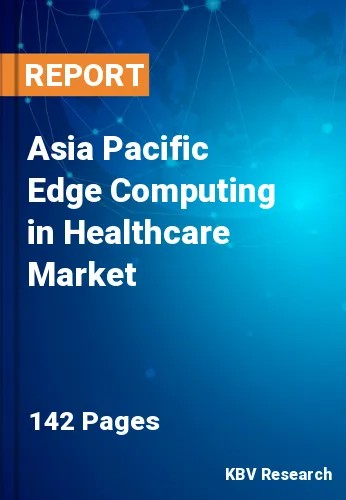The Asia Pacific Edge Computing in Healthcare Market would witness market growth of 27.9% CAGR during the forecast period (2023-2030).
Monitoring equipment frequently has a restricted connectivity range or is not connected to a central cloud. Hospitals and patients may be concerned about security while using such equipment because the enormous volumes of raw data it produces must be stored on a third-party cloud. To solve this problem, the hospital's property may host an on-premise edge solution. A network of this kind will be able to aggregate information from many sources inside the hospital and obtain pertinent information while protecting data privacy & adhering to rules. The AI-enabled edge solution will also store critical data on a secure cloud system and offer clinicians real-time notifications concerning strange patient trends and behaviors. Hospitals can work more productively, use resources more effectively, and pay less per patient by implementing edge computing.
For patient care & training purposes, the healthcare sector is quickly embracing AI, machine learning, and augmented and virtual reality. All of these technologies need considerable real-time data processing capabilities and proximity to the computational capacity provided by edge computing devices to efficiently provide meaningful and educational outputs in a healthcare system. Networking restrictions and latency considerations are necessary because of the high expense of sending enormous amounts of data to a central cloud network. Organizations are using edge computing in their current systems to solve this issue.
The Asia Pacific medical device sector is well established and ranges from high-end diagnostic imaging equipment to mass-market glucose monitors. There is a huge demand for gadgets like heart rate monitors, and fitness trackers among the wearable devices in the region. Moreover, investment in the health and technological developments of wearable devices has increased rapidly over the years in the Asia-Pacific region. The government of India is also sculpting its policies to transform the nation by creating opportunities for its citizens to have access to digital technologies. The government is empowering people to go digital thus more people will invest in wearable technologies to monitor their health.
The China market dominated the Asia Pacific Edge Computing in Healthcare Market by Country in 2022, and would continue to be a dominant market till 2030; thereby, achieving a market value of $1,815.5 million by 2030. The Japan market would showcase a CAGR of 27.1% during (2023 - 2030). Additionally, The India market is anticipated to grow at a CAGR of 28.7% during (2023 - 2030).
Based on Component, the market is segmented into Hardware, Software, and Services. Based on Application, the market is segmented into Telehealth & Remote Patient Monitoring, Diagnostics, Robotic Surgery, Ambulances, and Others. Based on End User, the market is segmented into Hospitals & Clinics, Long-term Care Centers & Home Care Settings, Ambulatory Care Centers, and Others. Based on countries, the market is segmented into China, Japan, India, South Korea, Singapore, Malaysia, and Rest of Asia Pacific.
Free Valuable Insights: The Worldwide Edge Computing in Healthcare Market is Projected to reach USD 25.5 Billion by 2030, at a CAGR of 26.9%
The market research report covers the analysis of key stake holders of the market. Key companies profiled in the report include Cisco Systems, Inc, Nokia Corporation, Dell Technologies, Inc., Amazon Web Services, Inc. (Amazon.com, Inc.), Google LLC (Alphabet Inc.), Microsoft Corporation, Intel Corporation, General Electric Company, Hewlett Packard Enterprise Company, and NVIDIA Corporation.
By Component
By Application
By End User
By Country
Our team of dedicated experts can provide you with attractive expansion opportunities for your business.

